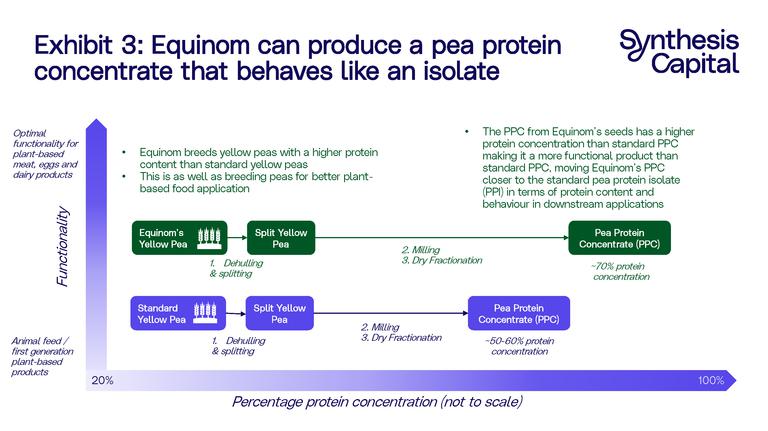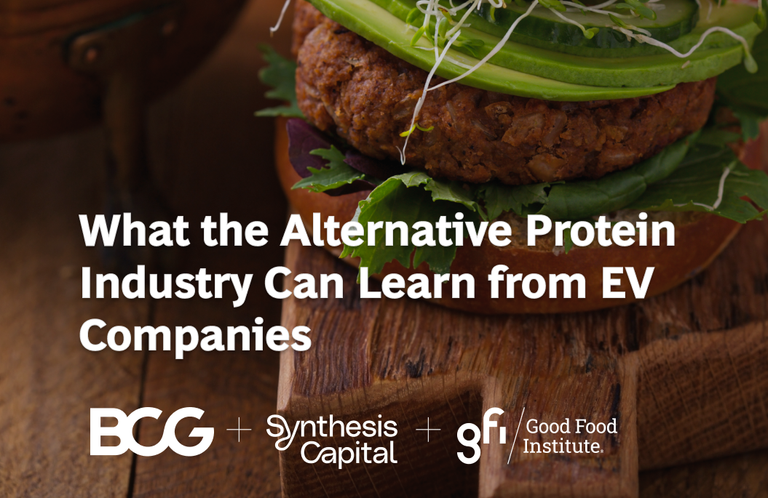How Can We Improve Plant-based Ingredients for Alternative Proteins?
• Technology • Investment • Feature
Why should we make plant-based ingredients better?
Meat has a distinct aroma and texture, whether it is the heady bite and spring of a freshly grilled steak, the pleasant softness of salmon, or the smell of bacon sizzling in a pan. These descriptions may have even started to make your mouth water. Not to mention the experience of cooking meat, dairy and eggs, and how the colours, textures and fragrances of the ingredients transform as they get closer to being put on your plate. The plant-based alternatives on the market today struggle to emulate this full experience.
How can plant-based alternatives capture this diverse set of attributes without adding huge numbers of extra ingredients? One way to do this is to go right back to the starting material – the crop. Whether it is soy, pea or wheat, all of these crops can be bred with better functionality more suited to mimicking the key attributes of meat, dairy and eggs.
This is no simple task. Today the majority of crops are used for animal feed; these few crops are commoditized, with supply chains optimised for the animal feed industry, and as such they are not suited for use in the plant-based foods on the supermarket shelves today. They can be low in protein, unable to mimic the all-important flavours and textures of meat, and also require heavy processing to become usable ingredients for plant-based foods. These crops may have worked well for the previous generation of plant-based foods, such as soy milk from pressed soybeans, veggie burgers and the more traditional tofu. However, they are not able to provide the properties needed to mimic meat, egg and dairy in a way that appeals to the majority of consumers. Meanwhile, possible new crops like lupin or mung bean, which may help provide some of these properties, do not yet have the robust supply chains needed for alternative proteins. While posing a challenge, this also creates an opportunity.
We know that crops can be better inputs for plant-based meat and dairy – but how can we breed better crops if we don’t know which genes influence these key properties? How can we discover which genes influence the texture in a whole cut of hybrid cultivated steak or the flavours in plant-based ice-cream?

Building a bridge between plant genetics and food ingredient functionality
The good news is that technology is on our side. Our understanding of genomics is advancing at an incredible rate, and that has only sped up over the last ten years. Computational biology is transforming the way we can use data along the value chain. We now have the ability and computing power necessary to develop AI algorithms that can cross-analyse the big data sets of genetic data and biochemical properties.
So, we have data about what gives food its nutrition and sensory properties, data from individual ingredients on their impact on biochemical and functional properties, and data from plants around genetics, phenotypes, and agronomics. We now need to bridge the gap between the three by linking genetics to the function of ingredients, and then the end-product characteristics, to allow informed and targeted decisions to be made around crop breeding. (See Exhibit 1).

Targeted breeding is key to producing the next generation of crop inputs for alternative proteins
The good news is this “three-way bridge” is a path trodden before outside of alternative proteins. Cotton-candy grapes[i], tastier tomatoes[ii], and wheat for better bread[iii], have all come about from using targeted breeding to close the gap between data around end-product characteristics, biochemical properties of ingredients, and the genetics of the crop.
For example, scientists from the USDA tested 173 varieties of tomatoes (from the 6,000 options in the seed library) for their consumer properties of odour, taste, texture and flavour. They then mapped this information with the biochemical properties of the tomatoes such as sugar, acid and vitamin C content. Surprisingly, despite the many biochemical properties, the answer was relatively simple with a positive correlation between flavour and the amount of sugar content in the tomato. This knowledge is invaluable to tomato breeders, who can change the flavour by adjusting the levels of these biochemical properties through targeted breeding.
Developing meat, eggs or dairy from plants is a more complex challenge. How do we assemble the right ingredients together to capture all the sensory attributes of meat or cheese? And which genes are involved?
There are a variety of tools currently in development to not only help breed crops more appropriate for the functionality of plant-based food, but also to do this faster, more efficiently, and with reduced time to market. Crops are being developed – or optimized – via breeding or genetic engineering to provide better ingredients, which then can be assembled into more desirable plant-based foods.
The advantages of improving the crops themselves go beyond the measures around the taste and texture of the end product, and stretch along the whole value chain. Optimising crops for farming and harvesting (e.g. yield and higher protein content) and processing (e.g. reducing the content of compounds that are responsible for off-flavours and colours) offer additional benefits around cost and nutrition. (See Exhibit 2)

Equinom offers a unique opportunity to unlock value across the whole value chain
At Synthesis. we recently invested in Equinom, an Israel-headquartered food tech and computational biology company which does just this. Equinom integrates computational biology and precision breeding to develop non-GMO variants of pea, sesame, and other crops with higher protein content, improved flavour, better processing capabilities, and other attributes that contribute to better plant-based food products.
Equinom’s team has a decade of research behind them, combining their deep expertise in seed genomics and plant breeding to link the precise DNA sequences in the seed’s genetic make-up to the functional traits of ingredients (such as gelling capability, solubility, taste). They do this through their proprietary computational biology platform, named “Manna”™, which connects genetic and other crop data with functional data on ingredients and end-products.
One example of the tools Equinom uses to efficiently gather and analyse data is an “electronic nose” that collects sensory data (such as flavour properties like bitterness, “beaniness” and grassiness ) on protein concentrates from different crop varieties, connecting these properties to the genetic code of each variety. These properties and genetics can be crossed in silico[iv] to predict the optimal new varieties for milder tasting proteins, while reducing the number of physical crosses that need to be performed. For example, new varieties of pea can be identified in silico and bred to produce pea protein concentrate with improved cost and better functional and sensory properties for use specifically for alternative proteins.
This knowledge bridge allows Equinom to breed superior varieties of pea and soy that not only perform better as ingredients in alternative meat and dairy applications, but also demonstrate better functionality and efficiency across the whole value chain.
For example, crops with higher protein content reduce the amount of land required to produce protein concentrate, and better protein functionality simplifies processing requirements, therefore reducing the cost whilst accelerating the timeline. As a result, Equinom’s pea protein concentrate behaves more like an isolate due to its higher protein content and genetic traits (See Exhibit 3).

Equinom is unusual in that it has expertise in both seed germplasm and computational biology. While the company only started to apply their platform to alternative proteins in 2017, they benefit from their existing large (and expanding) germplasm library, as well as an established non-GMO seed bank. While modern genetic engineering tools are being applied to solve similar problems (for example by using Molecular Farming), to be used effectively, we still need to build the bridge between the ingredient and food data. On top of this there are significant barriers to regulation for genetically engineered crops in many regions. By contrast, all markets are open to Equinom’s breeding approach, and therefore its crop varieties.
Conclusion
Our recent investment in Equinom is illustrative of Synthesis’s approach to solving pain points across the whole alternative protein value chain. We are delighted to have led this funding round and are excited to partner with the company in their next stage of growth. We believe that Equinom’s unique technology can contribute meaningfully to the transformation of the food system, and revolutionise the plant-based sector and the potential of alternative protein products more broadly.
[i] Plant breeders in California have created a grape that tastes like cotton candy. NPR. Please find a link here.
[ii] Breeding a tastier tomato. USDA. Please find a link here.
[iii] The Man Who Could Make Everyone’s Bread Taste Better. New York Magazine Intelligencer. Please find a link here.
[iv] In silico breeding is the application of computational biology to model and predict cellular, tissue, organ and whole plant development and ingredient functionality in parental lines and offspring. Equinom use in silico breeding to predict which crosses from their germplasm library will result in the optimal combination of growth, yield, sensory, and other properties for a particular application.


